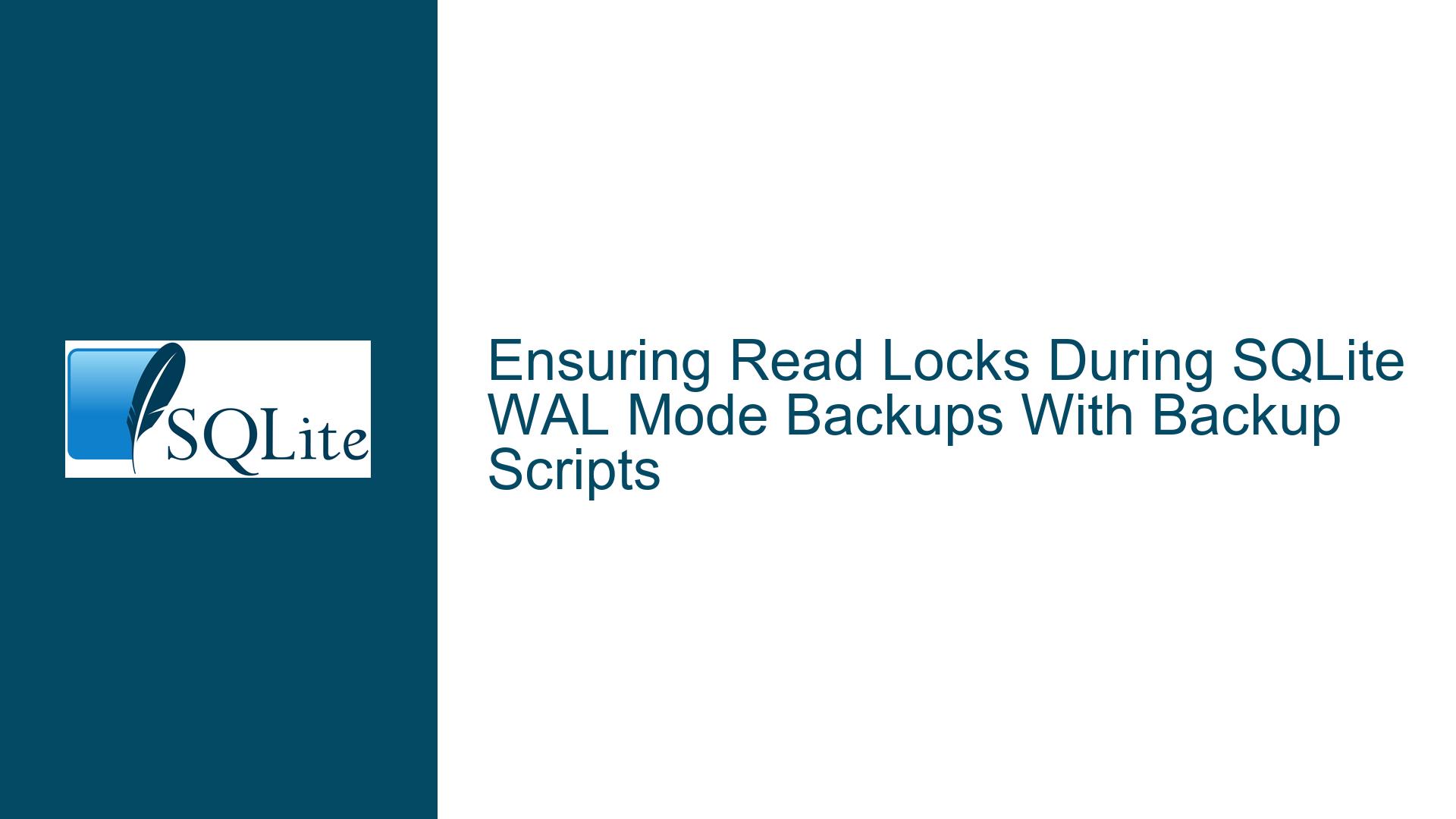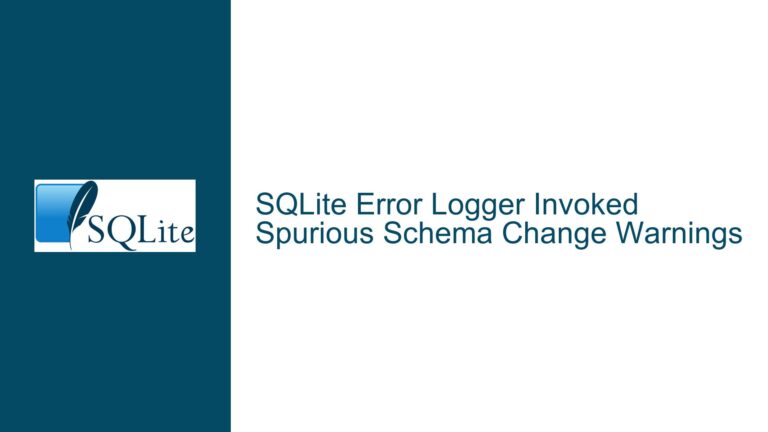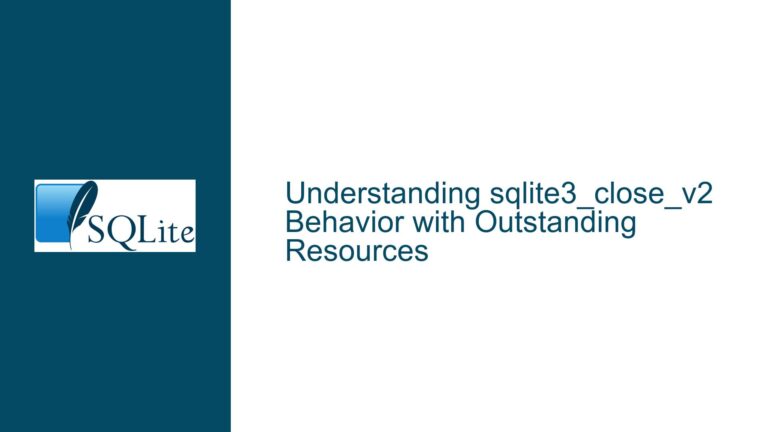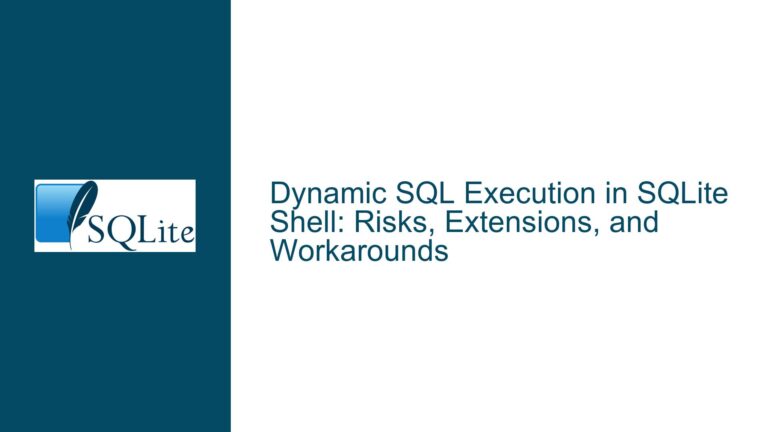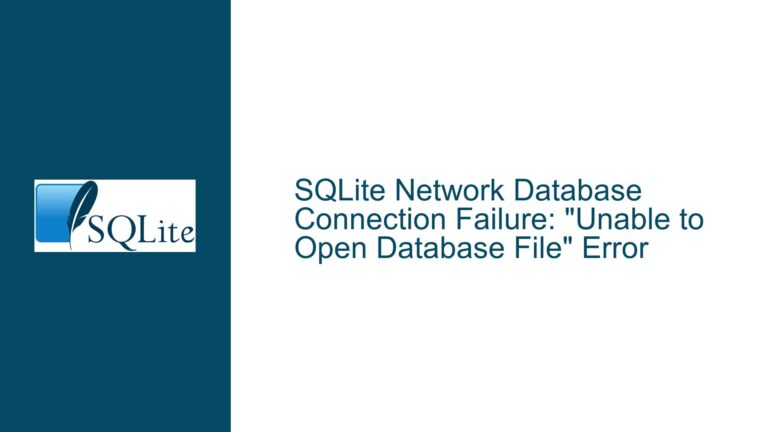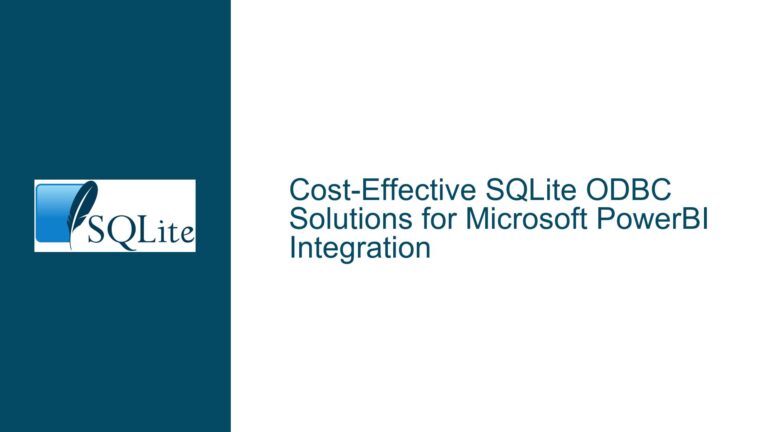Ensuring Read Locks During SQLite WAL Mode Backups With Backup Scripts
Lock Acquisition Mechanisms for SQLite Backups in WAL and Rollback Journal Modes
Inadequate Read Lock Guarantees During Concurrent Write Operations
The core challenge addressed by the script revolves around maintaining database consistency during backup operations in SQLite. When using Write-Ahead Logging (WAL) mode, SQLite allows concurrent read operations while writes occur, but backups require careful handling to capture a consistent snapshot of both the main database file and WAL file. The script attempts to acquire read locks through SQL statements executed via a persistent sqlite3 coprocess, then runs an external backup command like rsync. Three critical technical aspects emerge:
WAL File Append-Only Behavior: WAL mode’s append-only design theoretically allows safe copying of both *.sqlite and *.wal files if the backup occurs during a quiescent state where no active transactions are modifying the database. However, the WAL file must be copied atomically with the main database file to prevent mismatches.
Lock Hierarchy in Rollback Journal Mode: In traditional rollback journal mode (non-WAL), SQLite uses a stricter locking protocol. A SELECT statement acquires a SHARED lock, but writers obtain RESERVED/PENDING locks that block new SHARED lock acquisition. This creates race conditions where backups might proceed without proper synchronization.
Coproc Session Lifetime Management: The script maintains a persistent sqlite3 session using bash’s coproc feature to hold locks open while executing the backup command. Any premature termination of this session would release locks, potentially invalidating the backup consistency.
A fundamental assumption in the original script is that executing SELECT 1 FROM "dbname".sqlite_master suffices to acquire durable read locks. While valid in WAL mode due to its MVCC design, this approach becomes unreliable in rollback journal mode when concurrent writers hold PENDING locks. The script lacks mechanisms to verify successful lock acquisition or handle lock contention errors, risking silent backup corruption.
Lock State Contention Between Readers and Writers in Non-WAL Environments
Three primary factors contribute to potential backup inconsistency when using the script outside WAL mode:
1. Pending Lock Starvation in Rollback Journal Mode
When operating without WAL, SQLite’s locking states progress from UNLOCKED → SHARED → RESERVED → PENDING → EXCLUSIVE. A writer holding a PENDING lock prevents new SHARED locks from being acquired by readers. The script’s SELECT statements will fail with SQLITE_BUSY in this scenario, but the current implementation doesn’t detect such errors. This creates a race condition where backups might proceed without holding required locks.
2. WAL Checkpoint Timing Issues
The script performs PRAGMA wal_checkpoint(FULL) before acquiring locks. While this merges WAL contents into the main database file, it doesn’t guarantee that subsequent writes won’t occur during the backup process. In high-write environments, new WAL entries could accumulate after checkpointing but before rsync completes, leading to an incomplete backup if the WAL file isn’t also copied.
3. File Descriptor Handling in Coprocess Communication
The script uses file descriptor ${COPROC[1]} to send SQL commands but ignores the output descriptor ${COPROC[0]}. This prevents detection of errors from sqlite3, including lock acquisition failures. Any SQL errors or busy states go unnoticed, potentially resulting in unlatched backups. Bash’s coproc implementation also introduces subtle behavior regarding buffer flushing and process lifecycle management that could prematurely close the sqlite3 session.
4. Backup Command Synchronization Window
The time gap between lock acquisition and actual file copying creates a vulnerability window. For large databases, rsync may take significant time to transfer files, during which the sqlite3 coprocess must maintain open transactions and locks. Network latency or process scheduling delays could extend this window beyond practical limits.
Comprehensive Lock Verification and Backup Synchronization Strategies
Phase 1: Lock Acquisition Robustness Enhancements
1.1 Dual-Mode Lock Verification
Implement lock testing that works for both WAL and rollback journal modes:
for db in "${dbs[@]}"; do
# Use immediate transaction to force lock acquisition
echo "BEGIN IMMEDIATE; SELECT 1 FROM \"$db\".sqlite_master; COMMIT;" >&$I
# Read response from sqlite3 output descriptor
while read -t 5 -r line <&$O; do
if [[ "$line" == *"Error: database is locked"* ]]; then
echo "Lock acquisition failed for $db" >&2
exit 1
fi
[[ "$line" == "1" ]] && break
done
done
This uses IMMEDIATE transactions to force lock acquisition attempts and reads sqlite3’s responses through the coprocess output descriptor ($O).
1.2 WAL-Specific Backup Procedure
For WAL mode databases, explicitly handle WAL file copying:
wal_files=()
for db in "${dbs[@]}"; do
wal_files+=("${db}-wal")
done
(
echo "BEGIN;"
# Acquire read locks
# ...
echo "COMMIT;" # Releases locks but keeps connection open
) >&$I
# Now copy both DB and WAL files
rsync "${rsync_args[@]}" "${dbs[@]}" "${wal_files[@]}"
This ensures WAL files are included in the backup after locks are acquired but before connection closure.
Phase 2: Error Detection and Coprocess Management
2.1 Bidirectional Coprocess Communication
Modify the script to read from sqlite3’s stdout using a separate file descriptor:
exec {I}>&p # Write to coproc stdin
exec {O}<&p # Read from coproc stdout
Implement timeout-based reading to detect lock errors:
function sql_check_error() {
local timeout=5
while read -t $timeout -r line <&$O; do
if [[ "$line" == *"Error: "* ]]; then
echo "SQL ERROR: $line" >&2
return 1
fi
[[ "$line" == "$1" ]] && return 0
done
echo "Timeout waiting for SQL response" >&2
return 1
}
echo "SELECT 1;" >&$I
sql_check_error "1" || exit 1
2.2 Transaction Isolation Improvements
Use explicit transactions with conflict resolution:
echo "BEGIN EXCLUSIVE;" >&$I
# Instead of individual SELECTs
for db in "${dbs[@]}"; do
echo "SELECT count(*) FROM \"$db\".sqlite_master;" >&$I
done
echo "COMMIT;" >&$I
While EXCLUSIVE locks are heavier, they guarantee backup consistency at the cost of blocking writers.
Phase 3: Alternative Backup Methodologies
3.1 SQLite Online Backup API Integration
Instead of file copying, use SQLite’s built-in backup functionality via the .backup command:
for db in "${dbs[@]}"; do
echo ".backup main '${db}.backup'" >&$I
done
This method is more reliable but requires storing backups as new database files rather than direct file copies.
3.2 Snapshot Isolation via Export
Generate consistent snapshots using the .dump command:
for db in "${dbs[@]}"; do
echo ".dump \"$db\"" >&$I
done > backup.sql
While this creates logical backups rather than physical file copies, it guarantees transactional consistency.
3.3 Filesystem-Level Snapshot Coordination
Integrate with LVM/ZFS snapshots for atomic file capture:
# Create snapshot before releasing locks
echo "BEGIN; SELECT 1 FROM sqlite_master;" >&$I
lvcreate --snapshot --name dbsnap /dev/vg0/sqldata
echo "COMMIT;" >&$I
mount /dev/vg0/dbsnap /mnt/snap
rsync -a /mnt/snap/path/to/dbs/ backup/
Phase 4: Production-Grade Script Enhancements
4.1 Retry Logic with Exponential Backoff
Implement retries for transient lock conflicts:
retries=5
delay=2
for ((i=0; i<retries; i++)); do
if acquire_locks; then
break
fi
sleep $delay
delay=$((delay * 2))
done
4.2 Connection Keepalive Monitoring
Add heartbeat pings to detect coprocess failures:
(
while sleep 10; do
echo "SELECT 1;" >&$I
done
) &
heartbeat_pid=$!
trap "kill $heartbeat_pid" EXIT
4.3 Resource Cleanup Guarantees
Strengthen coprocess cleanup:
function close_coproc() {
echo ".quit" >&$I
wait $COPROC_PID
kill $heartbeat_pid 2>/dev/null
exec {I}>&-
exec {O}<&-
}
trap close_coproc EXIT INT TERM
This comprehensive approach addresses both WAL and rollback journal mode challenges while adding enterprise-grade error handling and recovery mechanisms. The final implementation would require balancing between lock strictness and application availability requirements, potentially offering configurable isolation levels via script parameters.
